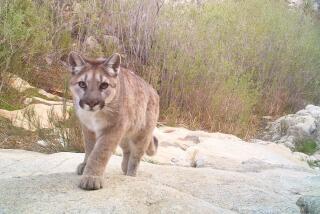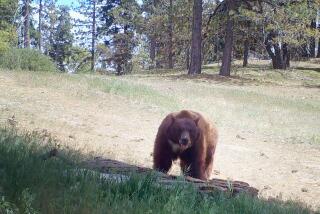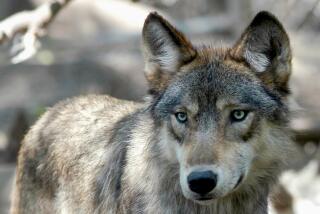An American wolf in Yellowstone
A matriarch overthrown in what seems fairly described as a “putsch,” marauding gangs running attacks into neighboring territory, an hours-long standoff with a grizzly, a discarded water bottle — a rarity in the wilderness of a national park — tossed around and protected like a prized new toy. The lives of the wolves in Yellowstone are often dramatic, but are full of touching, tender moments too, as Nate Blakeslee vividly writes in “American Wolf: A True Story of Survival and Obsession in the West.” As the book shows, wolves are social, downright empathetic creatures, the rare mammal species in which males will care for the young of another, and that can be said to have their own culture — traits they share with humans, their greatest predator.
Throughout history, wolves and humans have fought each other and at times embraced one another. Eventually the relationship hardened, and after humans overtook wolves as the most wide-ranging land mammal in the world — and we began bending nature more aggressively (and destructively) to our will — humans and wolves became diametrically opposed. Where humans live, the enduring approach has been, wolves cannot.
But so much about nature — a notion both defined and mitigated by humans’ relationship with the environment — and the ways we go about both exploiting and conserving it is caught up in emotion rather than fact. As Blakeslee shows, wolves are no exception. Here’s a species that, thousands of years ago, we found compelling enough to make our closest animal companion, only to much later all but eradicate it from the landscape — as we did in the U.S. by the 1920s, including in protected places like Yellowstone.
As wolves were reintroduced into Yellowstone National Park in 1995, the full range of emotions were on display. Scientists and conservationists were about to witness something that had never been attempted before, and were thrilled at the prospect of watching wolves reshape the land. But outside of the park, the return of wolves to the northern Rockies was not seen as cause for celebration. In Wyoming, Blakeslee writes, the state Legislature tried (and failed) to pass a bill that not only offered a $1,000 bounty for anyone who killed a wolf that wandered out of the park, but would cover the hunter’s attorney fees if they were charged for killing a protected species. It’s a divide that only hardened as wolves have wandered out of the park in the last two-and-a-half decades, repopulating growing stretches of the mountainous West.
The story of wolves and the people who now live alongside them boils down to a familiar question of extraction versus conservation.
“American Wolf” is ostensibly about a wolf and a hunter — a narrative that would be almost primal if the wolf, a charismatic alpha female called O-Six, wasn’t regularly being viewed through multiple telemetry lenses by the dedicated wolf spotters of Yellowstone, and if the hunter, Steven Turnbull (a pseudonym), wasn’t restricted by a litany of state and federal laws as he stalked his prey. No, the story of “American Wolf” is far larger in scope: the way we relate — or don’t — to wolves is not just symbolic of how we relate to nature, it’s symptomatic of what we will allow the construct that is nature to be.
As Blakeslee details, once wolves were removed from Yellowstone, game wardens had to become wolves themselves, culling the growing, complacent elk herds, whose overgrazing was causing significant damage to the park’s ecosystem. Between the 1930s and ’60s, officials were “shooting thousands of animals [elk] in an average year,” until surrounding communities and politicians persuaded them to stop. More elk in the park meant more elk migrating out of Yellowstone during winter and into mountain towns like Crandall, Wyo. — and the rifle scopes of tourists who pay local outfitters handsomely for the thrill of bagging a trophy. In the days before reintroduction, “you could pick the animal you wanted to shoot, almost like ordering from a catalog,” Blakeslee writes. Before wolves returned, there were 19,000 elk roaming across Yellowstone’s northern range; by 2010, that number was down to 6,000.
In addition to reducing the number of elk in the park, the return of wolves was felt across the ecosystem. This rippling effect caused by the wolves’ return is known as a “trophic cascade,” and in Yellowstone it helped lead the way to “an avian renaissance” in the park, not to mention increased numbers of everything from rodents to pronghorn antelope. With elk spending less time nibbling on the willows that hold down stream banks, riparian habitat for fish and other aquatic species was improved too. The whole ecosystem rejiggered itself into a state that hadn’t existed in centuries.
Before the final encounter between Turnbull and O-Six, and (spoiler alert) the widespread fallout of the death of what the New York Times called the world’s most famous wolf, another Yellowstone wolf known as 754 was shot just outside of the park in Crandall. While elk-hunting outfitters were by 2012 a thing of the past, new businesses had sprung up catering to tourists who wanted to spot a wolf, including one owned by Nathan Varley.
Blakeslee quotes an interview Varley gave to the New York Times after 754 was killed, where he asks who would compensate guides like him for the loss of “a million dollar wolf.” But even with wolves providing new livelihoods by way of tourist dollars, there are still many like Turnbull who would rather they be hunted. In the West, with its vast stretches of public lands, the story of wolves and the people who now live alongside them boils down to a familiar question of extraction versus conservation that surrounds timber, mining, ranching and other rural economies.
The ecosystem reshaped by wolves is arguably a more “real” West than that of the lazy-elk days before reintroduction, when easy hunting filled chest freezers and bank accounts alike. But both nostalgia and politics influence what you see to be as a more authentic and ideal vision of the northern Rockies — and America’s wild spaces on the whole. With empathy for both those who want to protect wolves and those who would rather see them dead — and a deep sense of awe and respect for the wolves themselves — Blakeslee has written a book that is as much about what fueled the Sagebrush Rebellion and the so-called civil disobedience of the Bundy family as it is about wildlife.
Blackmore is an editor for Popula, a new publication launching in early 2018. He lives in Maine.
“American Wolf: A True Story of Survival and Obsession in the West”
Nate Blakeslee
Crown: 320 pp., $28
More to Read
Sign up for our Book Club newsletter
Get the latest news, events and more from the Los Angeles Times Book Club, and help us get L.A. reading and talking.
You may occasionally receive promotional content from the Los Angeles Times.






